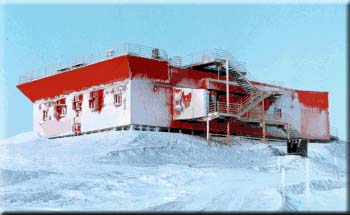

 
|
|
|
|
|
||
|
|

Climate Change Increasing Ozone Loss in the Arctic Stratosphere
Climate change may enhance the frequency and depth of severe stratospheric ozone loss in the Arctic and could delay the recovery of the Arctic ozone layer by a decade or more, according to an Environment Canada report that reviews recent science on the issue. Findings show the greenhouse gases that are warming the lower atmosphere are causing cooling in the Arctic stratosphere in spring-thereby promoting the formation of polar stratospheric clouds that allow ozone-destroying substances to cause more damage. Two factors make ozone destruction in the polar regions brutally efficient during the spring. One is the polar vortex, a nearly closed circulation system that isolates the polar stratosphere from sunlight and the surrounding atmosphere, causing it to become extremely cold. At temperatures of -80oC or lower, a second factor comes into play: the formation of polar stratospheric clouds. These frozen clouds cause ozone-depleting substances that are normally stable and therefore harmless to the ozone layer to break down into forms that are easily broken apart by solar radiation. With the return of sunlight in the spring, these unstable compounds release large volumes of chlorine and bromine-powerful ozone-depleting catalysts, each molecule of which can destroy thousands of ozone molecules before returning to the troposphere and being removed by other chemical reactions. 
Measurements of a single air mass as it moves around the Arctic vortex show how ozone concentrations decrease with accumulated exposure to sunlight, January 4 to February 9, 1992 (source: Arctic Ozone, 1998) Most of the world's ozone is produced over the tropics, but it is distributed all over the world by winds. Ozone forms in the stratosphere when oxygen atoms liberated by powerful ultraviolet (UV) rays combine with intact oxygen molecules. It is gradually destroyed by sunlight and natural chemical reactions, but there is usually enough new ozone coming in to replenish losses. In recent years, excessive volumes of ozone-depleting substances released into the atmosphere by human activity have caused ozone depletion. In six out of the last nine years, unusually low ozone values have been observed over the Arctic during the spring with ozone losses of up to 45 per cent reported in 1997. 
A computer model of the possible minimum and maximum Arctic ozone depletion until the year 2060 (source: Arctic Ozone, 1998) With lower stratospheric temperatures spurring the more frequent formation of these clouds and ozone-depleting industrial chemicals expected to be at or near peak levels for the next 10 to 20 years, the situation could worsen in the coming decades. Larger depletions in the ozone will expose highly sensitive Arctic lifeforms to significant increases in UV radiation from the sun, and could lead to reduced ozone levels over southern Canada as ozone is redistributed in the atmosphere. 
Stratospheric ozone observatory at Eureka on the west coast of Ellesmere Island. Further monitoring and research on the Arctic ozone layer is necessary to understand trends and atmospheric processes. Climate change and ozone depletion should be treated not in isolation, but as interrelated parts of a common strategy for moderating the human impact on the atmosphere. |
|
|
Home | Air | Atmospheric Science | Climate Change | Environmemental Action | Habitat | Pollution | Species at Risk | Technology | Water | Weather | Wildlife |
|
|
| Help
| Search
| Canada Site |
|
||
|
The Green LaneTM, Environment Canada's World Wide Web site
|
||
|
|
||
|
|
||